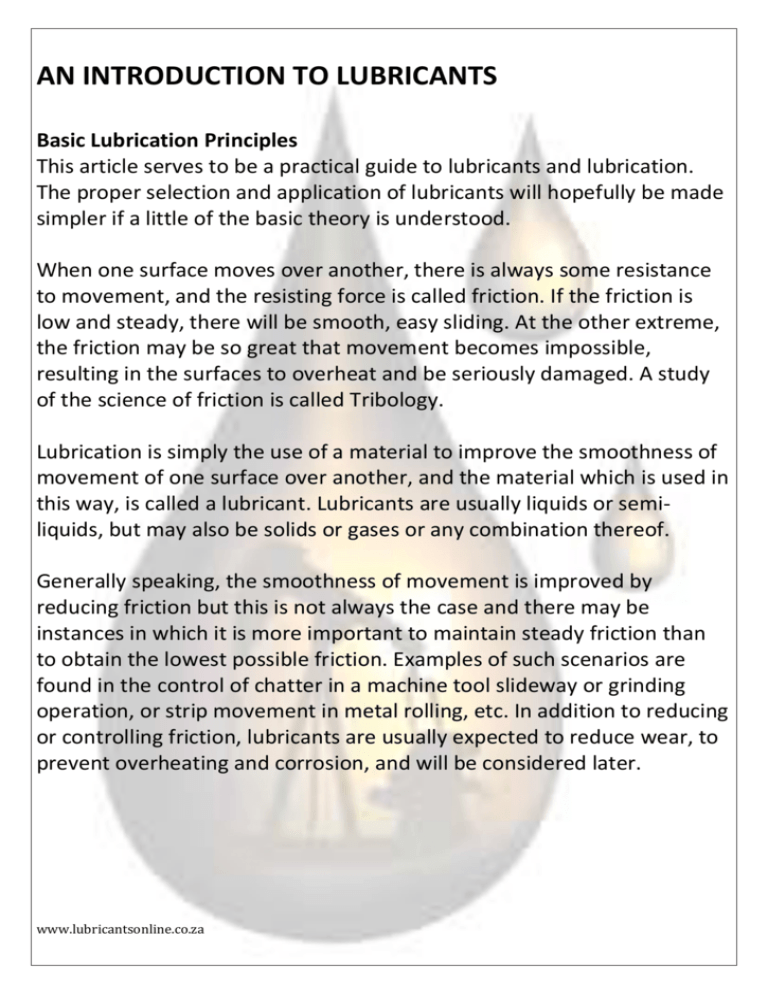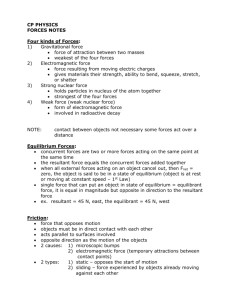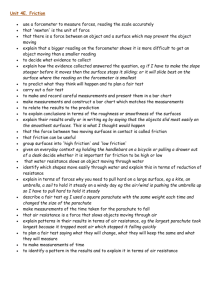Introduction to lubricants
advertisement

AN INTRODUCTION TO LUBRICANTS Basic Lubrication Principles This article serves to be a practical guide to lubricants and lubrication. The proper selection and application of lubricants will hopefully be made simpler if a little of the basic theory is understood. When one surface moves over another, there is always some resistance to movement, and the resisting force is called friction. If the friction is low and steady, there will be smooth, easy sliding. At the other extreme, the friction may be so great that movement becomes impossible, resulting in the surfaces to overheat and be seriously damaged. A study of the science of friction is called Tribology. Lubrication is simply the use of a material to improve the smoothness of movement of one surface over another, and the material which is used in this way, is called a lubricant. Lubricants are usually liquids or semiliquids, but may also be solids or gases or any combination thereof. Generally speaking, the smoothness of movement is improved by reducing friction but this is not always the case and there may be instances in which it is more important to maintain steady friction than to obtain the lowest possible friction. Examples of such scenarios are found in the control of chatter in a machine tool slideway or grinding operation, or strip movement in metal rolling, etc. In addition to reducing or controlling friction, lubricants are usually expected to reduce wear, to prevent overheating and corrosion, and will be considered later. www.lubricantsonline.co.za Mar-16 Friction In most cases dry friction between two bodies closely follows two laws which have been described by Leonardo da Vinci is about 1500. The first of these laws states that the friction between two solids is independent of the area of contact. If a brick slides over a flat surface, then the friction will be the same whether it is sliding on its base, or on its end. The second law is that the friction is proportional to the load exerted by one surface on the other. To continue the example of the brick, if a second brick is placed on the first the friction will be doubled, with a third brick, trebled, and so on. It is this second law which makes it possible to define the coefficient of friction. If the friction is proportional to the load, then the friction is equal to a constant multiplied by the load. F=constant x W or F/W = constant And this constant is the coefficient of friction, usually written as µ. The coefficient of friction depends mainly on the materials which are in sliding contact. The coefficient of friction between two bodies is, in fact not quite constant. It often varies slightly with change in load, and usually varies with sliding speed. The static friction, which is the force required to start one body sliding over another, is almost always greater than the dynamic friction, which is the force needed to keep it moving at the speed once sliding has started. www.lubricantsonline.co.za Page 2 Mar-16 The friction between two dry surfaces arises from two main sources, adhesion and deformation. Remember that even the smoothest engineering surfaces are rough when viewed under a high-powered microscope. Two solid surfaces touching one another will in fact only be in contact at the peaks of their asperities as shown in the exaggerated form in Fig 1. Fig. 1 Contact of Two Solid Surfaces If two surfaces touch, even with the load of a few grams, the load will be carried entirely on a small number of these asperities, and the actual contact pressure may be as high as 1400 MN/m² (200000 psi). Such enormous pressures can squeeze the asperities on hardened steel or cast iron surfaces out of shape, or even cause them to weld together. Once this happens, force is required to separate them and is determined by how great the adhesive friction is. The other main component of friction, deformation friction, is usually small and it is obvious why this must be so. The deformation which takes place when two surfaces rub together must be either elastic (temporary) or plastic (permanent). If it is the former, the energy which is used to produce the deformation will be recovered when the surface resumes its original shape and there will be no net friction. If it is plastic, there will be a permanent change in shape and the amount of change which can be tolerated in any engineering component is limited. There is one complication when some substances deform elastically though, in that there is a delay in their return to their original shape. www.lubricantsonline.co.za Page 3 Mar-16 When this happens, the energy released may be too late to be returned to the sliding system and there will be a net frictional loss. In addition elastic deformation can cause some loss of energy in the form of heat and can contribute towards fatigue damage. It should be noted that when two asperities adhere, they will often separate by a rupture, or tearing inside one of the surfaces. This results in a very small amount of material being transferred from one surface to the other so that there is in fact, some deformation taking place. The primary influence however, is adhesion and if it is reduced or eliminated, the resulting deformation will also be reduced or eliminated. The first requirement of all lubrication is thus the elimination or reduction of force required to shear the adhesive junction formed between asperities. This can be done either by interposing a material which is more easily sheared, or by using a chemical which will alter the shear stress of the asperities. As mentioned earlier, the material imposed, may be a gas, a liquid or a solid. If it is any of the first two types, then a third type of friction is introduced, notably, viscous friction (or viscous drag).This is the force required to shear a viscous fluid. The Mechanism of Lubrication The way in which liquids lubricate can be explained by considering the example of a bearing as shown in Fig. 2 Fig. 2 Lubrication of a bearing www.lubricantsonline.co.za Page 4 Mar-16 As the shaft rotates in the bearing, lubricating oil is dragged into the loaded zone and the pressure and the volume of the oil in the loaded zone, both increase. The pressure rise, and therefore the thickness of the oil film, will depend on the shaft speed and the lubricant viscosity. The relationship between speed, viscosity, load, oil film thickness and friction can be understood by considering a graph such as shown in Fig 3. Fig. 3 Stribeck Curve There are distinct zone in the graph. The coefficient of friction is at its lowest in the Hydrodynamic and Thin Film zones. It is at this point when the oil film is just thick enough to ensure that there is no contact between asperities on the shaft and bearing surfaces. As we move to the right of the graph in the hydrodynamic zone, the oil film thickness is increasing due to increasing viscosity of the oil, increasing speed or decreasing load and the coefficient of friction increases. Moving towards the left of the curve, the oil film thickness decreases so that the asperities rub against each other. The amount of rubbing, and thus the friction, increases as the oil film thickness decreases to the point described as mixed film zone. In this zone the oil film thickness has been reduced virtually to nil and the load between shaft and bearing is being carried on asperity contacts. www.lubricantsonline.co.za Page 5 Mar-16 As we move further left down the curve, the coefficient of friction is almost independent of load, viscosity and shaft speed. This zone is known as the boundary lubrication zone. The oil film thickness is too small to give full fluid separation of the surfaces and the asperities start to contact one another. Lubricant properties, other than the bulk viscosity, start to become important. In most normal situations asperities are initially coated with a film of oxide. When the asperities rub together, their tendency to adhere is relatively mild. However, once the oxide film is removed, the exposed metal surfaces have a very powerful tendency to adhere. To reduce friction and where under these conditions, require a better engineered lubricant with enhanced properties to reduce friction and wear. This can be done iin several ways. Adsorption – all solid surfaces tend to attract a thin film of some substance from their environment. Such films may be only a few molecules thick and are said to be “adsorbed” onto the surface. The strength of adsorption depends upon the electronic structure and “polar” molecules (those in which there is a variation in electronic charge) tend to be adsorbed with their molecules perpendicular to the surface. Thicker and more strongly adsorbed films will give greater protection to the metal surfaces, so the preferred boundary lubricants for such conditions, are long chain polar organic chemicals. Adsorption is a reversible process and an absorbed substance can be “de-adsorbed” if heated to a critical temperature, or displaced by a substance which is more strongly absorbed. This is valuable in boundary lubrication as the most strongly adsorbed substances present in the lubricant can be preferentially adsorbed. Chemisorption – After adsorption onto a metal surface, some substances will react with the metal or oxide surface to produce a new chemical compound. Such substances are said to be “chemisorbed”. These materials are more strongly bound to metal surfaces than are adsorbed materials, and the chemisorptions process is not reversible. www.lubricantsonline.co.za Page 6 Mar-16 Chemical reaction – Adsorbed and chemisorbed films are very effective in reducing friction and mild wear under light or moderate rubbing. They are however, fairly easily removed mechanically under severe rubbing conditions. To handle such situations, more reactive chemicals can be added to the lubricant to react with the metal surfaces and to produce protective films. Suitable films include organic compounds of chlorine, phosphorus and sulphur. Such materials are said to have Extreme Pressure (EP) properties. And are commonly used in gearbox and metal working fluids. The different lubrication zones have an important influence on wear but generally speaking the amount of wear which takes place depends on the severity with which surfaces rub against each other. As the oil film becomes thinner moving from right to left on the curve, there is increasingly severe contact between the surfaces and therefore, a greater tendency to wear. Choice of Lubricant Type If there were only a few lubricants available, the problem of lubricant selection would hardly arise. One would use the available oil or grease and put up with its shortfalls and disadvantages, and whatever equipment life it gave. This was generally the case before the midnineteenth century when things like animal fat, crude oil which seeped from the ground and natural graphite were used. Nowadays the variety of lubricants available is enormous. Most lubricant manufacturers can supply scores of different mineral or synthetic oils and greases. To add to the complexity of the matter, equipment is often designed and built before any thought is given to their lubrication or the lubricant is chosen as an afterthought. It is not uncommon for large and expensive equipment to fail because the wrong, or sub-standard, lubricant was used. www.lubricantsonline.co.za Page 7 Mar-16 In choosing a lubricant for a particular application, the objective should always be to obtain the best long-tem performance at the best possible cost… and this does not mean using the cheapest available lubricant. It is no use buying a cheap oil, if either the oil, or the equipment in which it is used, breaks down or maintenance cost soars as a direct result of the lubricant. Reliability is therefore far more important that price. There are four basic types of lubricants (oils, greases, dry lubricants and gases) and Fig. 4 summarizes their broad properties. It is important to select the lubricant type best suited for the design of the equipment it is to lubricate. Lubricant Property Hydrodynamic lubrication Boundary lubrication Cooling Low friction Ease of application Ability to stay in place Ability to seal Oil Grease Excellent Fair Dry Gas Lubricant Nil Good Poor to excellent Very good Fair to good Good Good to excellent Poor Fair Fair Good to excellent Nil Poor Poor Usually poor Fair Excellent Good Poor Good Poor Poor Very good Protect against corrosion Temperature range Volatility Fair to excellent Fair to excellent Very high to low Good to excellent Good Very good Fair to good Poor to fair Very good Low www.lubricantsonline.co.za Generally low Very poor Poor Excellent Very high Page 8 Mar-16 Flammability Compatibility Cost Complexity of design Life determined by Very high to very low Fair Generally low Fair Generally Depends low on gas Excellent Generaaly good Low to high Fairly high Fairly Fairly high high Fairly low Fairly high Fairly Generally high low Deterioration Deterioration Wear Ability to & maintain contamination supply Fig 4 Main lubricant types and their properties www.lubricantsonline.co.za Page 9 Mar-16 www.lubricantsonline.co.za Page 10







